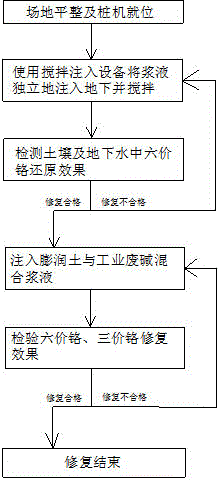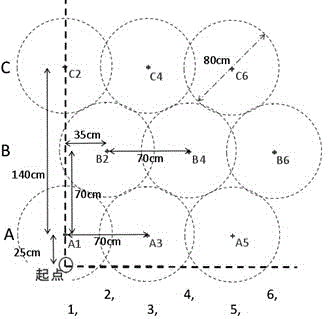Remediation method for hexavalent chromium polluted soil and underground water
A remediation method and a technology of polluted soil, applied in the restoration of polluted soil, contaminated groundwater/leachate treatment, water pollutants, etc., can solve the problem of large degree of damage to the rock and soil environment, re-pollution, dissolution and desorption of remediation capabilities In order to ensure fluidity and workability, enhance buffer capacity, and avoid seepage loss
- Summary
- Abstract
- Description
- Claims
- Application Information
AI Technical Summary
Problems solved by technology
Method used
Image
Examples
Embodiment Construction
[0044] The technical solution of the present invention will be described in detail below in conjunction with the accompanying drawings.
[0045] A kind of repairing method of hexavalent chromium polluted soil and underground water of the present invention, comprises the following steps:
[0046] Step 10): The pile driver is in place: use the total station to accurately release the pile position, and mark the point with lime, and then guide the stirring and injection equipment to be in place, so that the drill pipe and the stirring point are accurately aligned; when the stirring equipment is in place, consider The direction of "returning and hitting" is convenient for the machine to enter and exit; the stirring and injecting equipment is a one-way or two-way stirring machine. Material pipeline; when the stirring injection equipment is a two-way stirring injection equipment, the two-way stirring injection equipment is equipped with two sets of inner and outer drill pipes, and th...
PUM
| Property | Measurement | Unit |
|---|---|---|
| particle size (mesh) | aaaaa | aaaaa |
| density | aaaaa | aaaaa |
| particle size (mesh) | aaaaa | aaaaa |
Abstract
Description
Claims
Application Information
 Login to View More
Login to View More - R&D
- Intellectual Property
- Life Sciences
- Materials
- Tech Scout
- Unparalleled Data Quality
- Higher Quality Content
- 60% Fewer Hallucinations
Browse by: Latest US Patents, China's latest patents, Technical Efficacy Thesaurus, Application Domain, Technology Topic, Popular Technical Reports.
© 2025 PatSnap. All rights reserved.Legal|Privacy policy|Modern Slavery Act Transparency Statement|Sitemap|About US| Contact US: help@patsnap.com



